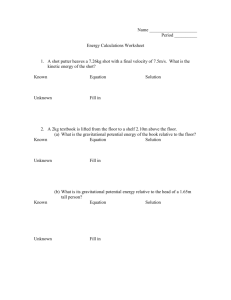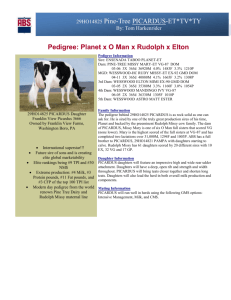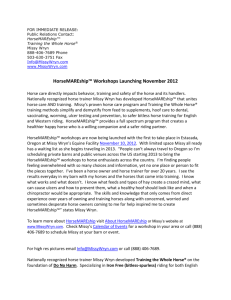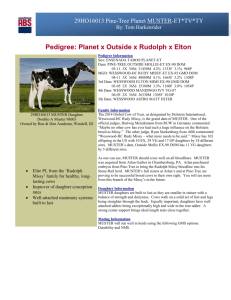File - Emma C. Craig
advertisement
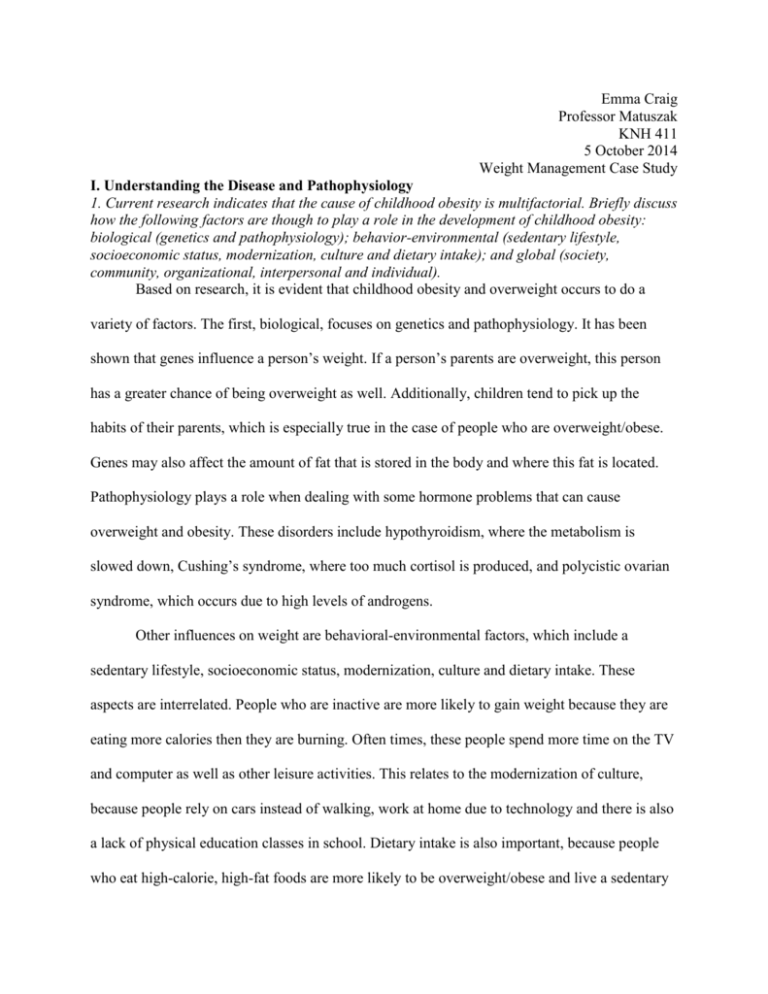
Emma Craig Professor Matuszak KNH 411 5 October 2014 Weight Management Case Study I. Understanding the Disease and Pathophysiology 1. Current research indicates that the cause of childhood obesity is multifactorial. Briefly discuss how the following factors are though to play a role in the development of childhood obesity: biological (genetics and pathophysiology); behavior-environmental (sedentary lifestyle, socioeconomic status, modernization, culture and dietary intake); and global (society, community, organizational, interpersonal and individual). Based on research, it is evident that childhood obesity and overweight occurs to do a variety of factors. The first, biological, focuses on genetics and pathophysiology. It has been shown that genes influence a person’s weight. If a person’s parents are overweight, this person has a greater chance of being overweight as well. Additionally, children tend to pick up the habits of their parents, which is especially true in the case of people who are overweight/obese. Genes may also affect the amount of fat that is stored in the body and where this fat is located. Pathophysiology plays a role when dealing with some hormone problems that can cause overweight and obesity. These disorders include hypothyroidism, where the metabolism is slowed down, Cushing’s syndrome, where too much cortisol is produced, and polycistic ovarian syndrome, which occurs due to high levels of androgens. Other influences on weight are behavioral-environmental factors, which include a sedentary lifestyle, socioeconomic status, modernization, culture and dietary intake. These aspects are interrelated. People who are inactive are more likely to gain weight because they are eating more calories then they are burning. Often times, these people spend more time on the TV and computer as well as other leisure activities. This relates to the modernization of culture, because people rely on cars instead of walking, work at home due to technology and there is also a lack of physical education classes in school. Dietary intake is also important, because people who eat high-calorie, high-fat foods are more likely to be overweight/obese and live a sedentary lifestyle. As for culture, society is at a point where portion sizes become bigger and bigger, yet people still eat them. Additionally, as mentioned before children who grow up in an overweight family often adopt the same lifestyle as their parents. It is also true that people who are of a lower socioeconomic status tend to be overweight due to their lack of access to healthy foods. It is cheaper to buy a fast food meal to feed a family compared to buying fresh fruits and vegetables or there is just no grocery store with these healthy options. Society, communities, organizations, interpersonal and individual factors play a role in obesity and overweight as well. A lot of factors have been mentioned, for example socioeconomic status relates to what sort of community a person lives in, and therefore what access to foods they have. What sort of parents a person has plays a big role as well interpersonally. Individual factors may relate to one’s dietary intake or current stress level, which may cause him/her to eat more. A community without sidewalks may correlate to higher rates of obesity due to a lack of physical inactivity. Additionally, in society food advertising plays a huge role in what people eat. Often times, the benefits mentioned during the food advertisements are exaggerated to seem much better than they really are. Depending on a person’s education level, they may be led to believe the ads. What Causes Overweight and Obesity? (n.d.). Retrieved October 13, 2014, from http://www.nhlbi.nih.gov/health/health-topics/topics/obe/causes.html 2. Describe health consequences associate with an overweight condition. Describe how these health consequences differ for an overweight versus obese condition. When dealing with overweight and obesity, many of the health consequences related to the disease are similar. When dealing with obesity, a patient is at much higher risk for these consequences, and at a much higher risk for morbid obesity as well. There are psychosocial and emotional consequences, such as feeling the pressure of being thin. Additionally, they may feel guilt, depression, anxiety and self-worth. Type two diabetes, metabolic syndrome, high blood pressure, lipid abnormalities, hepatobiliary disorders, cancers, reproductive disorders and premature death are all major health consequences overweight and obese people need to be aware of (Nelms, 253). 3. Missy has been diagnosed with obstructive sleep apnea. Define sleep apnea. Explain the relationship between sleep apnea and obesity. Sleep apnea is a disorder where there is one or more pauses in breathing while sleeping. When breathing resumes, there is often a snort or choking sound. Specifically, obstructive sleep apnea occurs when the throat muscles intermittently relax and block areaway during seep. This causes a child to stop breathing repeatedly during sleep. Obesity is a major risk factor for sleep apnea because as more weight is stored in the trunk and neck area, the harder it is for the respiratory tract to function properly. All of the pressure applied to the trunk and neck area when a child is laying on a flat surface may cause the throat muscles to relax. Obesity and Sleep. (n.d.). Retrieved October 13, 2014, from http://sleepfoundation.org/sleeptopics/obesity-and-sleep/page/0,1/ II. Understanding the Nutrition Therapy 4. What are the goals for weight loss in the pediatric population? Under what circumstances might weight loss in overweight children not be appropriate? Weight loss goals include gradual weight loss until BMI is less than 85th percentile. Weight loss should not exceed 1 lb/month in children 2-5 years or 2 lbs/week in older obese children and adolescents. Weight loss is not recommended for children seven years or younger, as they are still growing and developing. Extra calories and energy may be needed for essential growth spurts in such a young age of children. Weight loss may also not be necessary if a child has a preexisting condition. Treating the condition should be the main focus. If weight loss is absolutely necessary, the previous state goals should be taken into account for the pediatric population. Weight Management. (n.d.). Retrieved October 13, 2014, from http://www.stanfordchildrens.org/en/topic/default?id=weight-management-andadolescents-90-PO1626 5. What would you recommend as the current focus for nutritional treatment of Missy’s obesity? For Missy’s obesity, I would recommend the main focus to be cutting down on caloric content by replacing high-calorie “empty” foods with lower calorie foods that will offer her more nutrients, but are still filling to her. For example Missy drinks whole milk, which can easily be replaced with skim milk. She also has fried chicken and fried okra, which could be replaced with grilled chicken and okra. She eats a lot of processed food as sides, which I would recommend she switch out for apples, carrots or other fruits and vegetables. It would be small, subtle changes like this that would help Missy the most in the long run. Another important factor I would focus on would be to increase Missy’s physical activity. I would recommend she join some sort of team, this way she is exercising in a fun way and with children her age. I would also recommend her parents go on walks with her after dinner when the weather is appropriate. It would be extremely important to handle the weight loss and physical activity in a way in which Missy will not have emotional issues in later years. III. Nutrition Assessment A. Evaluation of Weight/Body Composition 6. Overweight or obesity in adults is defined by BMI. Children and adolescents are often times classified as “overweight” or at the “risk for overweight” based on their BMI percentiles, but this classification scheme is by no means universally accepted. Use three different professional resources and compare/contrast their definitions for overweight conditions among the pediatric population. According to the Harvard School of Public Health, there are three sources which each have definitions of overweight and obesity for children and adolescents. The first is the World Health Organization, which for children age five to nineteen, obese is classified as a BMI greater than 2 standard deviations above the WHO growth standard medium, and overweight is greater than 1 standard deviations above the WHO growth standard medium. According to the CDC, overweight is classified as between the 85th and 95th percentile of children their age, and obese is above the 95th percentile. The third is the International Obesity Task Force which classifies overweight and obese based on cut points for age and sex for children age 2 to 18. These cut points correspond to an adult BMI of 25 (overweight) or 30 (obesity). The World Health Organization and the International Obesity Task Force are similar in that they both use BMI in some sort of way, but do not just use solely BMI, rather they compare it to data. The CDC is different in that it uses a weight-for-height chart, which places the child in a certain percentile. The World Health Organization cut points are much higher than those of the International Obesity Task Force. This meaning that more children are classified as obese when using the International Obesity Task Force cutoff as compared to the World Health Organization cutoff. Defining Childhood Obesity. (n.d.). Retrieved October 13, 2014, from http://www.hsph.harvard.edu/obesity-prevention-source/obesity-definition/definingchildhood-obesity/#References 7. Evaluate Missy’s weight using the CDC growth charts provided. What is Missy’s BMI percentile? How would her weight status be classified by each of the standards you identified in question 6? Missy’s BMI: 115lbs/2.2kg=52.3 kg 57inchx2.54cm=144.7cm/100=1.45m 52.3/(1.452)= 24.9 Missy’s BMI percentile is right at the 97th percentile. According to the CDC, she would be classified as obese. According to the following chart from the World Health Organization Missy is at least 2 standard deviations over the growth standard medium, placing her in the obese category. According to the International Obesity Task Force , Missy would be classified as obese as she is on track to have a BMI above 30kg/m2 by the time she turns 18. BMI-for-age girls. (n.d.). Retrieved October 13, 2014, from http://www.who.int/growthref/cht_bmifa_girls_z_5_19years.pdf?ua=1 Cole, T., Bellizzi, M., Flegal, K., & Dietz, W. (2000, May 6). Abstract. Retrieved October 13, 2014, from http://www.ncbi.nlm.nih.gov/pmc/articles/PMC27365/ B. Calculation of Nutrient Requirements 8. If possible, RMR should be measured by indirect calorimetry. Identify two methods for determining Missy’s energy requirements other than indirect calorimetry and then use them to calculate Missy’s energy requirements. There are two ways in which Missy’s energy requirements can be calculated. These are the Mifflin-St. Jeor and Harris Benedict equation. UBW: 100-(5*3)=75lbs 75 + .25 (115-75)= 85lbs 85/2.2=38.6kg Mifflin-St. Jeor= 10x38.6 + 6.25 (145m)-5(10)-161= 1081.25 1081 x 1.5=1621kcal Harris Benedict: 655+(9.56x38.6) + (1.85 x 145) – (4.68x10)= 1245.47 1245.47x1.5=1867.65 Based on these two equations, Missy should be eating around 1600-1800 kcal per day. C. Intake Domain 9. Dietary factors associated with increased risk of overweight are increased dietary fat intake and increased kilocalorie-dense beverages. Identify foods from Missy’s diet recall that fit this criteria. Calculate the percentage of kilocalories from each macronutrient and the percentage of kilocalories provided by fluids for Missy’s 24-hour recall. Missy is eating many high-fat, high-calorie foods. These include: mayonnaise, bologna with cheese, peanut butter, fried chicken, breakfast burritos, whole milk, frito’s, twinkies, fried okra, and mashed potatoes. The high calorie drinks she has are whole milk, coffee creamer, sweetened tea and coca-cola. Based on the content above, the following can be calculated: Total calories: 3954 % fat=175.3x9=1577/3954=39.9% fat %carbs:440x4=1760/3954=44.5% carbs %protein:156x4=624/3954=15.8% protein The total percent of calories from drinks can be calculated as: 109 (coca-cola) +115 (tea)+208 (milk) +138 (milk) +138 (milk) +113 (coffee) + 138 (milk) + 52 (apple juice)= 1011/3954=25.5% calories from drinks Based on her food log, Missy consumes 40% fat, 45% carbs and 16% protein per day. Her total percent of calories from drinks is 26%. Fitday.com 10. Increased fruit and vegetable intake is associated with decrease risk of overweight. Using Missy’s usual intake, is Missy’s fruit and vegetable intake adequate? No, Missy’s fruit and vegetable intake is not adequate. According to the USDA girls age 10 should be having 1.5 cups of fruit and 2 cups of vegetables per day. Missy did have apple juice which counts as a fruit and fried okra and mashed potatoes which count as a vegetable. Her choices could be a lot healthier. For example she could have an apple or a banana instead of the juice. She could also have broccoli, green beans or mashed potatoes made with skim milk instead of fried, high fat vegetables. Choose a Food Group. (n.d.). Retrieved October 13, 2014, from http://www.choosemyplate.gov/food-groups/ 11. Use the MyPyramind Plan online tool to generate a personalized MyPyramid for Missy. Using this eating pattern, plan a 1-day menu for Missy. According to Choose MyPlate, Missy requires: Fruit: 1.5 servings Vegetable: 2 serving Grains: 5 ounces (1/2 whole grains) Protein: 5 ounces Dairy: 3 cups Empty: 120 kcal According to the DRIs, the total percent of carbohydrates should be 45-65%, the total percent of protein should be 10-35% and total percent of fat should be 20-35%. Based on this information, Missy can follow this food schedule: Breakfast: 1 slice whole wheat toast 2 tbsp peanut butter 1 cup skim milk 1 banana Lunch: 2 ounce turkey 1 ounce swiss cheese 2 pieces whole wheat bread 2 tbsp hummus 1 cup carrots After school snack: 6 oz cup yogurt 1/3 cup granola ½ cup orange juice Dinner: 1 grilled turkey breast ½ cup green beans ½ cup broccoli ½ cup brown rice Dessert: 1 cup chocolate skim milk **Drink water throughout the day when needed 12. Now enter and assess the 1-day menu you planned for Missy using the MyPyramid Tracker online tool. Does your menu meet macro-and micronutrient recommendations for Missy? Based on this information her kcal can be broken down into: Fat: 51.9X9=467.1/1760=26.5% fat Carbs: 240.9x4=54.8% carb Protein: 95.7x4=382/1760=21.2% protein These values fall within the micronutrient range. Based on the micronutrient range, there are a few changes I would recommend the family make of the diet plan created. First, I would recommend the family have red meat 1-2 times a week in order to increase the iron in Missy’s diet. Iron is extremely important for Missy as she is a young girl who will be entering puberty soon. I would also recommend Missy have a citrus fruit at some days in her diet in order to increase her Vitamin C levels. The final major change I would make is for Missy’s family to buy low-sodium foods in order to decrease her sodium intake. Missy could follow this diet one day but would need to be sure she balances out the micronutrient range throughout the week. A good aspect of the food plam is Missy is within her micronutrient and calorie range for the day. Fitday.com D. Clinical Domain 13. Why did Dr. Null order a lipid profile and blood glucose test? Dr. Null ordered a lipid profile and glucose test for Missy to check for any values that were abnormal due to her being considered obese for such a young age. As mentioned previously, there are many health complications that come with being obese such as: diabetes, hypertension and many more. The chances of these could be seen through her HDL, LDL, cholesterol, glucose and A1C levels. It would be extremely important to try and resolve any health issues that could be seen through tests before Missy gets older and it gets harder for her to make changes. 14. What lipid and glucose levels are considered to be abnormal for the pediatric population? The following values are considered to be normal for the pediatric population, anything outside of these ranges would be abnormal: Value CHOL HDL LDL LDL/HDL Ratio VLDL TG HbA1c Glucose Normal Range 120-199 mg/dL >55 mg/dL <130 mg/dL 3.22 7-32 mg/dL 35-135 mg/dL 3.9-5.2 % 70-110 mg/dL 15. Evaluate Missy’s lab results. Value Normal Range Missy’s Values CHOL 120-199 mg/dL 190 HDL >55 mg/dL 50 LDL <130 mg/dL 110 LDL/HDL Ratio 3.22 2.2 VLDL 7-32 mg/dL 30 TG 35-135 mg/dL 114 HbA1c 3.9-5.2 % 5.5 Glucose 70-110 mg/dL 108 Missy’s values are very indicative of her current weight status. She shows borderline high levels of TG, HDL, VLDL and glucose. She has low levels of LDL, meaning she is not getting enough healthy fats in her diet. These levels put her at a high chance of developing many of the health consequences that come with being obese. At such a young age, the development of these complications should prevented as soon as possible. Her high HbA1c levels as well as glucose could be indicative of diabetes, as she also has family history of diabetes. E. Behavioral-Environmental Domain 16. What behaviors associated with increased risk of overweight would you look for when assessing Missy’s and her family’s diet? The behaviors I would look at when assessing Missy’s family is their physical activity, general daily activities, where they live, what they have access to (sidewalks, parks, etc.) and hobbies the family has. It would be important to know their daily activities to see if the family drives, takes the bus or walks to places. If the family has access to sidewalks and parks, it would be a good way to get in exercise, but not necessarily to follow an “exercise regimen”. Also, I would want to suggest to the family fun hobbies that require physical activity. When it comes to Missy’s family’s diet history, I would be very interested in many factors. I would want to know the education level of the parents and if they are aware of healthy foods vs. unhealthy foods. I would also want to know who does the cooking and shopping in the family. I would look into where most of the calories from Missy’s diet come from and also where the high levels of fat come from. I would want to know if most of the food she is eating is processed or fresh. The quality of the food would also be another major factor I would consider. For example if she is eating white bread instead of whole grains, or having whole milk yogurt vs. skim milk yogurt. I would also look into when and where she is eating. For example, she may eat breakfast before school but not have lunch until noon, so I may need to add in a healthy snack in her diet. 17. What aspects of Missy’s lifestyle place her at increased risk for overweight? There are many aspects of Missy’s lifestyle that place her at an increased risk for overweight. To begin, she has a family history of gestational diabetes, type 2 diabetes and has been overweight since she was born. She has occasional knee pain, which may contribute to her sedentary lifestyle. She also enjoys video games and reading, which are sedentary. She also eats a very high-calorie diet with poor nutrition. 18. You talk with Missy and her parents. They are all friendly and cooperative. Missy’s mother asks if it would help for them to not let Missy snack between meals and to reward her with dessert when she exercises. What would you tell them? I would recommend Missy’s parents allow her to have snacks in between meals. Allowing her to eat small smacks will prevent her from overeating at main meals. The parents need to be sure Missy is eating healthy, small snacks. According to Missy’s food recall, she had a sandwich and whole milk, which could be considered a full meal. Instead, Missy should consider a snack to be a ½ cup of carrots with 2 tbsp hummus or an apple with 1 tbsp peanut butter. I would also not recommend Missy’s parents reward her with dessert when she exercises. Using food as a reward has been linked to children overeating foods that are high in sugar, fat and empty calories. It also disrupts a child’s usual dietary intake. It also may encourage children to eat when they are not hungry as a reward. Missy will learn to exercise only because she wants a reward, not because she wants to be healthy. Also, the calories from the dessert may completely cancel out the calories Missy burned off during exercise. Instead, Missy should have goals set in mind with a reward not related to food. For example, if she works out four days a week for three weeks, she can have a sleepover with friends or go to a movie. This way, she still is being rewarded but not with food. University of Rochester Medical Center. (n.d.). Retrieved October 13, 2014, from http://www.urmc.rochester.edu/encyclopedia/content.aspx?ContentTypeID=160&Conten tID=32 19. Identify one specific physical activity recommendation for Missy. I would recommend Missy’s parents sign up her for a youth club soccer team. This will have multiple benefits for Missy. To begin, the CDC recommends youths get at least 60 minutes of moderate-vigorous physical activity daily. Generally, sports team practice every day for at least an hour. In addition, Missy will be with a team. The people on the team can help keep her motivated and Missy may look forward to going to practice if she has friends on the team. Also, by playing a sport, Missy will not feel like she is being forced to exercise. It is not like running on the treadmill everyday for an hour. Hopefully this will also help strengthen her knee that occasionally has pain. This will give her an opportunity to compete, be physically active and make friends. Physical activity guidelines. (2014, March 5). Retrieved October 13, 2014, from http://www.cdc.gov/healthyyouth/physicalactivity/guidelines.htm IV. Nutrition Diagnosis 20. Select two high-priority nutrition problems and complete PES statements for each. 1) Undesirable food choices (NB-1.7) related to high-calorie, high-fat consumption of processed foods and beverages as evidenced by 24-hour recall and macronutrient distribution of 40% fat, 45% carbs and 16% protein per day. 2) Excessive energy intake (NI-1.3) related to consumption of unhealthy food choices and a 4000 calorie diet as evidenced by being in the 97th percentile and classified as obese. V. Nutrition Intervention 21. For each PES statement written, establish and ideal goal (based on signs and symptoms) and an appropriate intervention (based on etiology). 1) Goal: The goal I would set for Missy for the first PES statement is to eliminate the highcalorie beverages as well as the high-calorie, high-fat foods Missy is eating in her diet. Intervention: In order to do this, I will create a weekly meal plan for Missy. In this meal plan, I will substitute her whole-milk choices for skim milk. Instead of eating process foods, I will place fresh fruit and vegetables in her diet plan. I will ask her to write down the ones she does and does not like so I can make a better meal plan the next week. Missy is still young, so I will allow for one treat week, such as ice cream or a cookie. 2) Goal: Reduce Missy’s calories to her recommended 1700-1800 kcal per day. Intervention: As mentioned previously, I would create a food plan that Missy can follow every day. It will be very detailed with portions sizes that her parents can follow as they feed her everyday. This diet plan will build down about 500-600 calories per week until she is set at her 1700. I do not want Missy to cut down her calories sudden and feel hungry all the time. 22. Mr. and Mrs. Bloyd ask about using over-the-counter diet aids, specifically ALLI (orlistat). What would you tell them? I would not recommend Missy use over-the-counter diet aides, specifically ALLI. Alli is specifically designed for overweight adults. I would tell them the FDA and the manufacturer both state that anyone younger than 18 should not use Alli. This is due to the fact experts are unsure if the drug interferes with the way a teen’s body grows and develops. There is a drug that is similar to Alli but it is prescribed and only for people who are 12 or older. Missy would not qualify for this either. Due to Missy’s young age, it is completely possible for Missy to lose the weight without having to rely on diet aides. This will also teach her how to lose weight in a healthy way and not rely on diet aides for her whole life. Is the Alli Diet Pill Right for Me? (n.d.). Retrieved October 13, 2014, from https://www.brennerchildrens.org/KidsHealth/Teens/Diseases-andConditions/Overweight-and-Obesity/Is-the-Alli-Diet-Pill-Right-forMe.htm?__taxonomyid=1641 23. Mr. and Mrs. Bloyd ask about gastric bypass surgery for Missy. What are the recommendations regarding gastric bypass surgery for the pediatric population? According to the EAL, gastric bypass surgery is not recommended unless adolescents are severely obese and have not achieved weight-loss goals with less-invasive methods. It is a very risky surgery. Also, the children who qualify must be severely obese, have co-morbities that will be resolved with weight loss and have attained a majority of skeletal maturity. These children must also have a supportive family and want the intervention. There have also been no long-term effect studies of children having this surgery. EAL. (n.d.). Retrieved October 13, 2014, from http://www.andeal.org/template.cfm?template=guide_summary&key=1383&highlight=p wm&home=1 VI. Nutrition Monitoring and Evaluation 24. When should the next counseling session with Missy be scheduled? According to the American Journal of Pediatrics, since Missy is having a comprehensive multidisciplinary intervention, we should have weekly visits for the next 8-12 weeks, and then month follow-up visits after this. If this is not possible, weekly phone calls should take place. I would schedule the first meeting exactly a week from the date she came in. I would try and have the meetings the same time every week to set a schedule for Missy. Recommendations for Treatment of Child and Adolescent Overweight and Obesity. (n.d.). Retrieved October 13, 2014, from http://pediatrics.aappublications.org/content/120/Supplement_4/S254/T1.expansion.html 25. Should her parents be included? Why or why not? According to the American Journal of Pediatrics, parents should be involved. This way the parent can watch over the child and become educated themselves. This will ensure the child is on the right path and the parents are being completely supportive of the child. It will also allow the parents to communicate any issues with the dietitian instead of having to relay the information through Missy and possible having miscommunications. Recommendations for Treatment of Child and Adolescent Overweight and Obesity. (n.d.). Retrieved October 13, 2014, from http://pediatrics.aappublications.org/content/120/Supplement_4/S254/T1.expansion.html 26. What would you assess during this follow-up counseling session? I would monitor Missy’s weight every week to make sure she is losing weight, but no more than two pounds a week. If she has access to a cellphone or computer I would ask her to write down a general idea of what she is eating, as a casual food log. I would want to know her hunger levels throughout the week too in case more or less food needs to be added. Depending on what foods Missy says she likes or dislikes, I will adjust her food log accordingly. I would ask how her new exercise routine is going and see if she enjoys being on a team. I would ask if she is interested in any other sorts of physical activity. If the parents were interested in more educational resources, I would also offer those. I would also wait about three weeks to check her blood levels so that there is time to adjust. I would hope her HDL increases, and LDL, TG, Cholesterol and A1c have decreased. References BMI-for-age girls. (n.d.). Retrieved October 13, 2014, from http://www.who.int/growthref/cht_bmifa_girls_z_5_19years.pdf?ua=1 Choose a Food Group. (n.d.). Retrieved October 13, 2014, from http://www.choosemyplate.gov/food-groups/ Cole, T., Bellizzi, M., Flegal, K., & Dietz, W. (2000, May 6). Abstract. Retrieved October 13, 2014, from http://www.ncbi.nlm.nih.gov/pmc/articles/PMC27365/ Defining Childhood Obesity. (n.d.). Retrieved October 13, 2014, from http://www.hsph.harvard.edu/obesity-prevention-source/obesity-definition/definingchildhood-obesity/#References EAL. (n.d.). Retrieved October 13, 2014, from http://www.andeal.org/template.cfm?template=guide_summary&key=1383&highlight=p wm&home=1 Is the Alli Diet Pill Right for Me? (n.d.). Retrieved October 13, 2014, from https://www.brennerchildrens.org/KidsHealth/Teens/Diseases-andConditions/Overweight-and-Obesity/Is-the-Alli-Diet-Pill-Right-forMe.htm?__taxonomyid=1641 Nelms, M. (2011). Nutrition therapy and pathophysiology (2nd ed.). Belmont, CA: Wadsworth, Cengage Learning. Obesity and Sleep. (n.d.). Retrieved October 13, 2014, from http://sleepfoundation.org/sleeptopics/obesity-and-sleep/page/0,1/ Physical activity guidelines. (2014, March 5). Retrieved October 13, 2014, from http://www.cdc.gov/healthyyouth/physicalactivity/guidelines.htm Recommendations for Treatment of Child and Adolescent Overweight and Obesity. (n.d.). Retrieved October 13, 2014, from http://pediatrics.aappublications.org/content/120/Supplement_4/S254/T1.expansion.html University of Rochester Medical Center. (n.d.). Retrieved October 13, 2014, from http://www.urmc.rochester.edu/encyclopedia/content.aspx?ContentTypeID=160&Conten tID=32 Weight Management. (n.d.). Retrieved October 13, 2014, from http://www.stanfordchildrens.org/en/topic/default?id=weight-management-andadolescents-90-P01626 What Causes Overweight and Obesity? (n.d.). Retrieved October 13, 2014, from http://www.nhlbi.nih.gov/health/health-topics/topics/obe/causes.html

